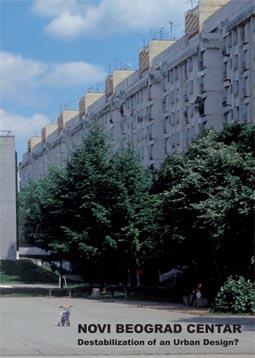Novi Beograd Centar - Destabilization of an Urban Design?

Students: Sabine Herzog, Helen Wyss
Location: Group work in Belgrade
Date: July, 2006
Type: Research project, student work
After the WWII the idea of a new administrative capital for the new Federative Republic of Yugoslavia to be created in the marshlands of river Sava, gained in importance. This new city was to span between the two historical cores: Old Belgrade and Zemun. Starting from 1947., the reclamation of the river Sava swamps took 22 million cubic meters of sand and a work force of 100.000. Over a period of one decade, international and Yugoslav competitions were called and numerous plans were drawn for the construction of the new capital. Finally the New Belgrade Center, as we see it today, was planned in 1962. It was a radically modern plan based on an abstract grid, a composition of nine squares laid out in the newly reclaimed land.
The central motive of this plan was a monumental axis; with the Palace of Federation from 1947 on one end and the railway station New Belgrade, never realized, on the other. New Belgrade was never completed to its original intentions but in the end its structure would ideally even have taken over the tissue of old Belgrade. It already lived through a whole series of ideological changes since the 1950s: Communism, Non-Align-Movement, Civil War, Milosevic, and their Post-forms.
The land reclamation followed by the conception of the ‘capital city’ and than the sudden turn towards the large-scale construction of housing in the form of ‘superblocks’ and ‘megablocks’ in the 1960s and 70s largely formed the panorama of Belgrade as we know it today. As the power of the state eroded in the 80s and 90s, urbanization by no means ceased; the ‘wearing and tearing’ of New Belgrade was nearly as impressive as its construction. Disarmed of ideals, alterations proceeded in a manner of entropy of individual and small scale interventions that infused the modernist structure. New Belgrade is the territory where the succession of official planning and construction projects and the powerful inclination to informality and one-off solutions collided with equal force.
The communist era left New Belgrade with an unfinished center and housing estates for a quarter of a million people, without any other functions however: bare naked. The brief postmodernist period scattered its ‘critique’ in-between the ‘blocks’ in a form of fast prefab-shopping malls and the first ‘human scale’ housing. The era of wild capitalism added to that numerous commercial, leisure, entertainment, housing, working and other colorful constructions, built under hazy auspices of crises, but with a volume and urbanistic accuracy that can be commended. As an unintended consequence of these persistent atom-size alterations, New Belgrade for the first time became complex and polycentric. These changes cannot simply be characterized as ‘post communist’ urban developments as there already have been many changes since communism ended in Yugoslavia.
The most dramatic changes in the built-up form of New Belgrade seem to take place today. Again it is the largest construction site of Belgrade with hundreds of thousands of new square meters. Many housing projects are planned and realized. The generous, monumentally modernist layout with large axial open spaces of the Centre of New Belgrade offers the opportunity for large-scale commercial and religious in-fills that could not easily find a place anywhere else, such as mega-malls, sport halls, churches and markets. Large infrastructural works have returned as well, such as the new bridge that will connect New Belgrade with city on the eastern riverbanks.
The density increases and the relation between private and public changes. New functions, typologies and new architectural languages are introduced. The character of these developments -churches, commercial buildings and perimeter blocks inserted into the previously open, modernist green spaces- we can see as an exact conceptual opposite to the modern plan it ‘inhabits’.
Although the character of the developments in the center of New Belgrade is painfully disenchanted and reflects all the symptoms of pluralism in making with an absence of direction and of ‘public interests’, it is clear that metropolitan character of New Belgrade has already arrived, even if it is still obscured by nostalgia for modernism, the anger over wilderness and the confusion about the future. What is fascinating is to see how New Belgrade is finally becoming the new metropolitan center of the city.
Download the Book PDF

